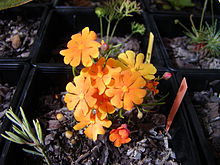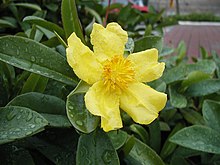Hibbertia: Difference between revisions
Melburnian (talk | contribs) →List of Species: Hibbertia fasciculata |
Melburnian (talk | contribs) →List of Species: Hibbertia prostrata |
||
| Line 50: | Line 50: | ||
*''[[Hibbertia pedunculata]]'' - Stalked Guinea-flower |
*''[[Hibbertia pedunculata]]'' - Stalked Guinea-flower |
||
*''[[Hibbertia procumbens]]'' |
*''[[Hibbertia procumbens]]'' |
||
*''[[Hibbertia prostrata]]'' - Bundled Guinea-flower |
|||
*''[[Hibbertia riparia]]'' - Erect Guinea-flower |
*''[[Hibbertia riparia]]'' - Erect Guinea-flower |
||
*''[[Hibbertia scandens]]'' – Climbing Guinea-flower or Snake Vine |
*''[[Hibbertia scandens]]'' – Climbing Guinea-flower or Snake Vine |
||
Revision as of 10:16, 19 March 2011
| Hibbertia | |
|---|---|

| |
| Hibbertia stellaris | |
| Scientific classification | |
| Kingdom: | |
| (unranked): | |
| (unranked): | |
| (unranked): | |
| Order: | unplaced
|
| Family: | |
| Genus: | Hibbertia Andrews[1]
|
| Species | |
|
See text. | |
Hibbertia, or Guinea flower, is a genus of perennial shrubs, trailing shrubs and climbers of the family Dilleniaceae. The five-petalled flowers of all species are varying shades of yellow, with the exception of H. stellaris, H. miniata and H. selkii, a recently named (1980s) species from the Stirling Ranges, which all have orange flowers. The genus numbers around 150 species but is currently being revised by Helmut Toelken of the South Australian Herbarium and this is likely to increase.
There are around 115 species, of which about 110 are native to Australia, the others occurring in Madagascar and on Pacific islands.[2]
The genus takes its name from George Hibbert (1757 - 1837), an eminent English merchant and amateur botanist.
Identification
Given the similarity in flower colour and shape (In nearly all species, the five petals are obovate), the number of stamens is a useful method of identification as this can vary widely from 4 to about 200 depending on species.
List of Species


- Hibbertia amplexicaulis
- Hibbertia aspera - Rough Guinea-flower
- Hibbertia banksii
- Hibbertia basaltica
- Hibbertia bracteata
- Hibbertia cuneiformis - Cut-leaf Hibbertia
- Hibbertia dentata - Twining Guinea-flower
- Hibbertia diffusa
- Hibbertia empetrifolia - Tangled Guinea-flower
- Hibbertia fasciculata
- Hibbertia furfuracea
- Hibbertia grossulariifolia - Gooseberry-leaved Guinea-flower
- Hibbertia hirta
- Hibbertia hypericoides - Yellow Buttercups
- Hibbertia linearis
- Hibbertia miniata - Orange Guinea-flower
- Hibbertia obtusifolia - Hoary Guinea-flower
- Hibbertia pedunculata - Stalked Guinea-flower
- Hibbertia procumbens
- Hibbertia prostrata - Bundled Guinea-flower
- Hibbertia riparia - Erect Guinea-flower
- Hibbertia scandens – Climbing Guinea-flower or Snake Vine
- Hibbertia selkii
- Hibbertia serrata
- Hibbertia sericea - Silky Guinea-flower
- Hibbertia serpyllifolia
- Hibbertia stellaris – Star Guinea-flower
- Hibbertia truncata - Port Campbell Guinea-flower
- Hibbertia vestita
References
- ^ "Hibbertia". Australian Plant Name Index (APNI), IBIS database. Centre for Plant Biodiversity Research, Australian Government, Canberra. Retrieved 18 March 2011.
- ^ "Hibbertia". PlantNET - New South Wales Flora Online. Royal Botanic Gardens & Domain Trust, Sydney Australia. Retrieved 18 March 2011.
